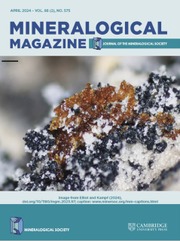No CrossRef data available.
Article contents
Growth and dissolution features in hydrothermal vein minerals – a study of Colombian emeralds using SEM and element-distribution mapping
Published online by Cambridge University Press: 14 July 2025
Abstract
Beryl crystals from hydrothermal veins in the Colombian emerald mining district, were examined to understand their growth and dissolution processes. Chemical analysis reveals minor substitution of Al by Na, Mg and the colouring elements V, Cr and Fe. Growth features include characteristic indentations on (0001) and a ridge-and-valley structure on the second-order prism, which is also observed on rare conical growth faces. Zoning is the primary internal growth feature, investigated in cross sections parallel to the main growth directions, the a- and c-axes of beryl. All crystals show sector zoning, with enrichment of Na and Mg in the c-sector, whereas Al and most of the trace elements measured are concentrated in the a-sector. H2O and CO2 molecules in the crystal structure were identified by infrared spectroscopy. Two types of H2O are present, with the H–H vector aligned (type I) and perpendicular (type II) to the c-axis, with H2O II predominant in the c-sector. CO2 is present in both sectors, decreasing from core to rim, and is higher in the a-sector. Variable sector boundaries suggest irregular changes in the growth rate in the two growth directions. The substitution (VIMg+channelNa)c-sector = (VIAl+channel□)a-sector creates a pattern of stripes, originating at the steps of the sector boundaries. Etch pits as a result of dissolution are arranged in chains, typically forming etching channels, but the overall amount of dissolution is minor. The arrangement of the etch pits indicates that they formed on dislocation bundles, which originate at the sector boundaries. The observations indicate rapid crystallisation with skeletal growth in [0001] is responsible for the distribution of elements in sectors, and are consistent with a closed-system behaviour in the veins.
Keywords
Information
- Type
- Article
- Information
- Copyright
- © The Author(s), 2025. Published by Cambridge University Press on behalf of The Mineralogical Society of the United Kingdom and Ireland.
Footnotes
Guest Editor: Barbara Dutrow
This paper is part of a collection in tribute to the work of Edward Grew at 80

